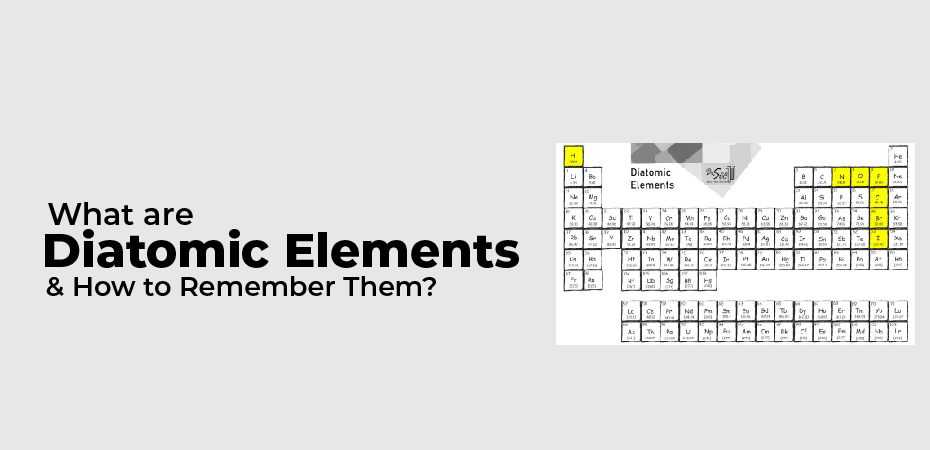
What are Diatomic Elements & How to Remember Them?
Table of Contents
The diatomic elements don’t like being alone – so much so that they aren’t found as single atoms.
They’re always made up of two atoms of the same pure element bonded together. The name is right there: Di- means “two,” and Atomic means “of atoms.” And elements are the fundamental building blocks of the universe.
There are only seven diatomic elements in the entire periodic table:
- Hydrogen H2
- Nitrogen N2
- Fluorine F2
- Oxygen O2
- Iodine I2
- Chlorine Cl2
- Bromine Br2
What is a Diatomic Element?
A diatomic element is a molecule made up of two of the same atoms. The word diatomic derives from ‘di’ meaning two and ‘atomic’ meaning atom. An element with a single atom is called a monatomic element.
Diatomic elements are most stable in this paired form since they can follow the octet rule. Therefore, there are generally no single atoms of oxygen or chlorine floating around. Instead, they are diatomic elements or molecular elements in the form of F2 or O2, the diatomic element or molecular element form.
The bromine molecule is one of the seven diatomic molecules
Diatomic elements are sometimes referred to as homonuclear diatomic molecules. Molecular homonuclear means that both atoms in the molecule are the same.
Despite the fact that there are only seven, they are not rare! They are among the most prevalent elements in our atmosphere. We breathe in 21% oxygen (O2) and 78% nitrogen (N2).
Other atoms may temporarily combine to form a diatomic element. However, they are not stable in this state and last only for a short period of time. As a result, they are not considered one of the seven diatomic elements.
What is a Diatomic Molecule?
Molecularly, a diatomic molecule is a molecule with two atoms, which can be different atoms. For instance, carbon monoxide (CO) is a diatomic molecule, but NOT a diatomic element. Nitric oxide (NO) is another example of a diatomic molecule.
Carbon monoxide (CO) is a diatomic molecule, not a diatomic element
Therefore, our diatomic elements are also diatomic molecules. However, not every diatomic molecule is a diatomic element.
A diatomic molecule with two different atoms is also known as a heteronuclear molecule. The two atoms are heteronuclear.
How to Remember the Diatomic Elements
There are several ways to remember which elements are diatomic. First, all diatomic elements have some common properties.
- One is that they are all non-metal. There are no diatomic metal elements.
- Secondly, all non-halogen diatomic elements end in ‘-gen’. The halogen group also ends in ‘-gen’.
You can also memorize the shapes of the elements on the periodic table (image below). In the standard periodic table layout, all of the elements are adjacent to one another except for hydrogen. They also form an upside-down L.
Finally, there are many ways to remember the first letter of each element. It’s intuitive to start with hydrogen, then move across the periodic table, and then down the halogens. You can match the letter to the element this way. Below are a few examples of sayings. You can also make your own.
Feel No Fear Of Ice Cold Drinks
(Hydrogen, Nitrogen, Fluorine, Oxygen, Iodine, Chlorine, Bromine)
A second and third option:
He Needed Oxygen For Controlling Both Insects.
(Hydrogen, Nitrogen, Oxygen, Fluorine, Chlorine, Bromine, Iodine)
I Have No Cats Breaking Famous Opals
(Iodine, Hydrogen, Nitrogen, Chlorine, Bromine, Fluorine, Oxygen)
Some people also use the word ‘BrIClHOF’ (pronounced brinkle-Hoff) which incorporates the chemical symbol of the element.
Why Only Seven?
There are really only seven diatomic elements. At room temperature and normal pressure, five of them are gases: hydrogen, nitrogen, fluorine, oxygen, and chlorine. They’re sometimes called elemental gases. Bromine is always a liquid, whereas iodine can be either a liquid or a solid at room temperature, depending on a number of factors. All seven are nonmetallic.
Some elements of the course can bond together; these are called diatomic molecules. This is how we get table salt (sodium + chlorine = NaCl, sodium chloride). Diatomic molecules like this are found everywhere. Several other elements can form diatomic molecules, but the bonds are very weak and unstable. They don’t stay diatomic for long. The seven diatomic elements form strong bonds and are almost always found in this form.
Diatomic elements are not rare, on the contrary! Nitrogen and oxygen, in their diatomic forms N2 and O2, constitute 99 percent of Earth’s atmosphere. That’s the opposite of rare.
Need an easy way to remember these seven? Use this mnemonic: Have No Fear Of Ice Cold Beer. Each word contains the first letter of the diatomic element.